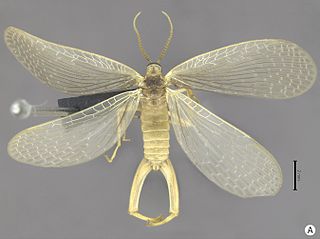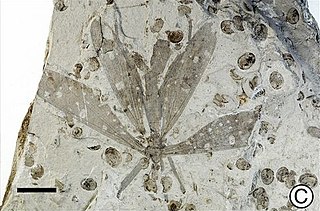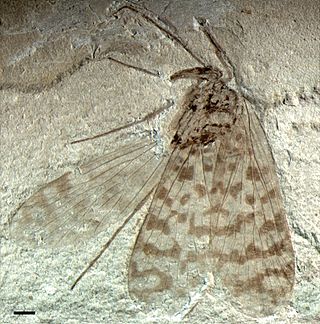
Mecoptera is an order of insects in the superorder Holometabola with about six hundred species in nine families worldwide. Mecopterans are sometimes called scorpionflies after their largest family, Panorpidae, in which the males have enlarged genitals raised over the body that look similar to the stingers of scorpions, and long beaklike rostra. The Bittacidae, or hangingflies, are another prominent family and are known for their elaborate mating rituals, in which females choose mates based on the quality of gift prey offered to them by the males. A smaller group is the snow scorpionflies, family Boreidae, adults of which are sometimes seen walking on snowfields. In contrast, the majority of species in the order inhabit moist environments in tropical locations.

Meropeidae is a family of tiny scorpionflies within the order Mecoptera with only three living species, commonly referred to as "earwigflies". These include the North American Merope tuber, the Western Australian Austromerope poultoni, and the recently discovered South American A. brasiliensis. The biology of these species is essentially unknown, and their larvae have never been seen. The disjunct distribution suggests a common origin before the breakup of the ancient supercontinent of Pangaea. There are two undisputed extinct genera, Boreomerope antiqua known from an isolated wing found in the Middle Jurassic Itat Formation of Siberia and Burmomerope with three species from the mid Cretaceous (Cenomanian) aged Burmese amber. As such, the extant members of this family can be considered living fossils. These insects are also of interest due to their presumed basal position in the order Mecoptera. Thaumatomerope with four described species all from the Madygen Formation in Kyrgyzstan has historically sometimes been included within the family, it was placed into its own monotypic family, "Thaumatomeropidae." in 2002.

Nannochoristidae is a family of scorpionflies with many unusual traits. It is a tiny, relict family with a single extant genus, Nannochorista, with eight species occurring in New Zealand, southeastern Australia, Tasmania, Argentina and Chile. Due to the group's distinctiveness from other scorpionflies, it is sometimes placed in its own order, the Nannomecoptera. Some studies have placed them as the closest living relatives of fleas. Most mecopteran larvae are eruciform, or shaped like caterpillars. Nannochoristid larvae, however, are elateriform, and have elongated and slender bodies. The larvae are aquatic, which is unique among mecopterans. The larvae are predatory, hunting on the beds of shallow streams, primarily on the larvae of aquatic Diptera like chironomids.

Bittacidae is a family of scorpionflies commonly called hangingflies or hanging scorpionflies.

The Panorpidae are a family of scorpionflies containing more than 480 species. The family is the largest family in Mecoptera, covering approximately 70% species of the order. Species range between 9–25 mm long.

Eomeropidae is a family of aberrant, flattened scorpionflies represented today by only a single living species, Notiothauma reedi, known from the Nothofagus forests in southern Chile, while all other recognized genera in the family are known only as fossils, with the earliest definitive fossil known from Liassic-aged strata, and the youngest from Paleogene-aged strata.

The Choristidae are a small family of scorpionflies known only from Australia. Their larvae are found in moss mats.

Dinopanorpidae is a small family of extinct insects in the order Mecoptera (scorpionflies) that contains two genera and seven species.

Mesochorista proavita is an extinct species of scorpionfly from the Triassic period of Queensland, Australia.

Juracimbrophlebia is an extinct genus of hangingflies that lived during the Middle Jurassic Period about 165 million years ago, containing only its type species, Juracimbrophlebia ginkgofolia; it was discovered in deposits from Daohugou in northeastern China’s Inner Mongolia.

Miriholcorpa is an extinct genus of scorpionfly (Mecoptera) from the Middle Jurassic period of China. The type and only species is M. forcipata, described in 2013.

Fortiholcorpa paradoxa is an extinct species of scorpionfly (Mecoptera) from the Middle Jurassic of China. It is the only known species of its genus.

Jurassipanorpa is a genus of fossil scorpionfly containing two species described in 2014 from the Jiulongshan Formation of Inner Mongolia, China. The two species, J. impuctata and J. sticta, lived in the late Middle Jurassic period. Upon description, they were claimed to represent the oldest known representatives of the scorpionfly family Panorpidae, but this was later questioned.
Platycrossos is an extinct genus of protocoleopteran beetles in the family Permosynidae. It is known from the Triassic and Jurassic of Australia, Austria, Mongolia and Russia. Like other members of the family, the species of this genus were described from fossils of isolated elytra with punctate striae.

Holcorpa is a genus of extinct insects in the scorpionfly order Mecoptera. Two Eocene age species found in Western North America were placed into the genus, H. dillhoffi and H. maculosa.

Holcorpidae is an extinct family of scorpionfies. It contains two genera, Conicholcorpa which is known from the Middle Jurassic Daohugou beds of Inner Mongolia, China, and Holcorpa, known from the Eocene of North America, including the McAbee Fossil Beds of British Columbia, and the Florissant Formation of Colorado. Members of this family are distinguished by their unusually long male genitalia, as well as characteristics of their wing venation. Both Miriholcorpa and Fortiholcorpa from the Middle Jurassic of China also have affinities to this family, but the incompleteness of their remains and differences from known holcorpids make their placement uncertain.

Mesopsychidae is an extinct family of scorpionflies known from the Late Permian to Mid Cretaceous. It is part of Mesopsychoidea, a group of scorpionflies with siphonate proboscis. They are suggested to have been nectarivores, feeding off the liquid pollination drops and acting as pollinators for now extinct insect pollinated gymnosperms such as Bennettitales.
Worcestobia is an extinct genus of scorpionfly. It is the only member of the family Worcestobiidae. It was described to contain two species originally assigned to Orthophlebia. Worcestobia gigantea was originally described by Robert John Tillyard in 1933 for NHMUK I. 11102 a hindwing found in the Rhaetian aged Lilstock Formation near Strensham, Worcestershire, United Kingdom The other species, Worcestobia haradai was described in 1991 from KMNH IP 000,002 a forewing found in the Carnian aged Momonoki Formation in a mine near Okuhata, Yamaguchi Prefecture, Japan. It is distinguished from other members of Panorpoidea by "the forking of Rs2 into two long veins Rs2a and Rs2b"

Choristopsychidae is an extinct family of scorpionflies, known from the Jurassic of Asia. The family was erected by Andrey Vasilyevich Martynov in 1937 to house Choristopsyche tenuinervis from the Early Jurassic (Pliensbachian) aged Sulyukta Formation in Kyrgyzstan. In 2013, two additional species in the genus Choristopsyche as well as a new second genus Paristopsyche containing the single species Paristopsyche angelineae were described from the Middle-Late Jurassic Jiulongshan Formation of Inner Mongolia, China. The family is noted for its distinctive broad wing shape, unique amongst mecopterans. Several members of the family have a distinct spotting pattern on the forewings.

Orthophlebiidae is an extinct family of scorpionflies known from the Triassic to Cretaceous, belonging to the superfamily Panorpoidea. The family is poorly defined and is probably paraphyletic, representing many primitive members of Panorpoidea with most species only known from isolated wings, and has such been considered a wastebasket taxon.

















